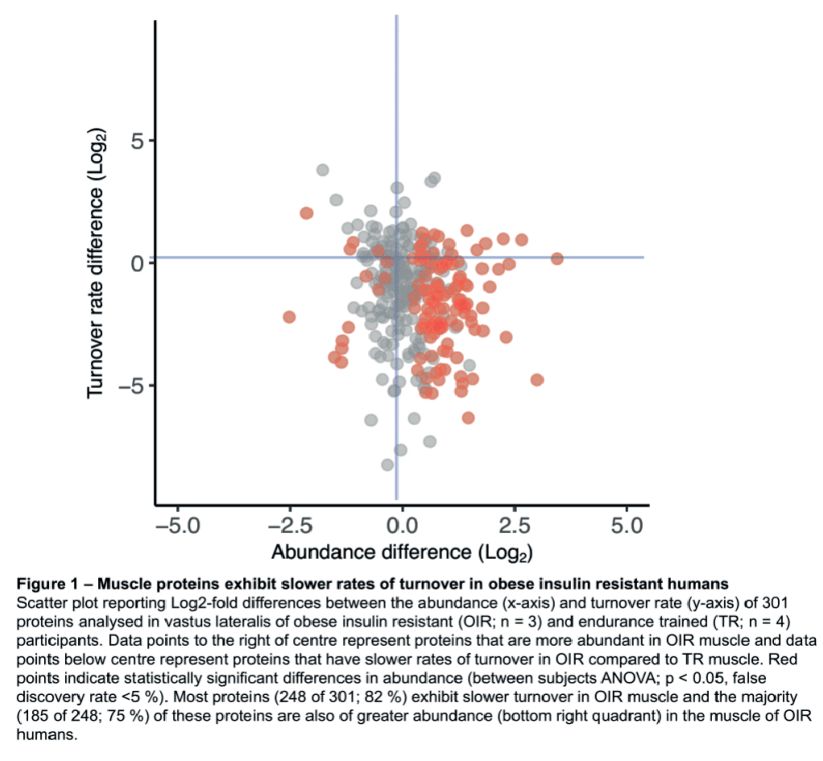High-intensity interval training (HIIT) is an attractive training strategy for improving performance and protecting against chronic metabolic disease. Changes to muscle function are underpinned by dynamic proteome remodeling but little is known regarding how exercise alters the turnover of individual proteins in humans. We compared individual protein abundance and turnover rates in obese insulin resistant (OIR; n = 3) and healthy, trained (TR; n = 4) male participants (38 ± 8 years), and conducted longitudinal analysis of proteome changes in OIR after 10-weeks HIIT. Newly synthesised proteins were labelled by oral consumption of deuterium oxide (D2O; 50 ml of 99.8 atom %) taken 4 times per day, for 14-days. Biopsies of vastus lateralis were performed before D2O administration (day 0) and after 4, 9, and 14 days of labeling. The OIR group trained 3 times/ week for 10-weeks (4 x 60 s cycling at 100% maximum power output interspersed by 60 s recovery periods). Training volume was increased by 1 interval bi-week and the experimental protocol was repeated over the final 2 weeks of HIIT. Physiological measurements were taken > 72 h before and after HITT and D2O incorporation and protein abundance data were quantified by liquid chromatography-tandem mass spectrometry. Baseline data were compared by between subject ANOVA and within-subject ANOVA was used to compare pre- vs post-HIIT responses. By design, the average BMI (kg.m-2) of OIR (34.0 ± 5.8) was greater (P = 0.02) than TR (24.2 ± 2.4 kg.m-2) participant, whereas peak oxygen consumption (VO2peak; ml.kg-1.min-1) of OIR (26.1 ± 4.4) was significantly (P < 0.01) less than TR (45.5 ± 7.9) and OIR had significantly (P < 0.01) lower insulin sensitivity (Matsuda Index; OIR = 1.7 ± 0.6 vs TR = 5.7 ± 1.4). HIIT increased VO2peak by 9 % (P = 0.25) and peak power output by 14 % (P = 0.06) in OIR. Abundance and turnover rate data were quantified for 880 and 301 proteins, respectively, in all OIR and TR participants. In total 352 proteins exhibited significant (p < 0.05, false discovery rate < 5%) differences in abundance at baseline (Figure 1). OIR muscle was enriched with markers of cellular stress and protein unfolding, including small heat shock proteins (HSPB; 1, 2, 3, and 6) and members of the 90 kDa HSP family. Additionally, HSP72, and cytoprotective enzymes such as alcohol dehydrogenases (AK1A1, and ALDH2) exhibited significantly slower turnover rates in OIR. HIIT significantly (p < 0.05) altered the abundance of 53 proteins and increased the turnover rate of 20 proteins in OIR muscle. Four proteasome subunits that were more abundant in OIR muscle compared to TR at baseline, significantly decreased (p < 0.05) in abundance post-exercise. Significant (p < 0.05) increases were also observed in the turnover rate of HSP7C, HS90B, as well as the antioxidant and detoxifying enzymes PRDX2 and ALDH1. These data indicate greater proteotoxic stress and impaired proteome dynamics in OIR muscle and provide insight to exercise-induced changes in protein-specific abundance and turnover rates that act to restore muscle proteostasis.
Biomedical Basis of Elite Performance 2022 (University of Nottingham, UK) (2022) Proc Physiol Soc 49, PC53
Poster Communications: High intensity interval training attenuates the loss of proteostasis in obese insulin-resistant muscle.
Connor A. Stead1, Jatin G. Burniston1, Katie Hesketh1, Mark Pogson2, Juliette A. Strauss1, Matt Cocks1, Ivo Siekmann3, Stuart M. Phillips4, Paulo J. Lisboa3, Sam O. Shepherd1, Kanchana Srisawat1
1 Research Institute for Sport & Exercise Sciences 2 Department of Communication and Media, University of Liverpool 3 Department of Applied Mathematics, Liverpool John Moores University 4 Department of Kinesiology, McMaster University
View other abstracts by:
Where applicable, experiments conform with Society ethical requirements.

